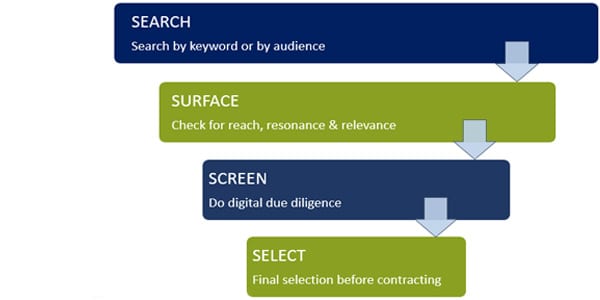 75% of communications professionals say identifying relevant influencers is their biggest influencer marketing challenge. For good reason: Identifying the most appropriate influencers at scale is a blend of PR skill, collective experience and technological acumen. To help enhance your influencer marketing efforts, I have created a “4S filter” to make the process of finding and choosing influencers a bit easier (click to tweet). This influencer identification filter breaks the process down into four core elements:
75% of communications professionals say identifying relevant influencers is their biggest influencer marketing challenge. For good reason: Identifying the most appropriate influencers at scale is a blend of PR skill, collective experience and technological acumen. To help enhance your influencer marketing efforts, I have created a “4S filter” to make the process of finding and choosing influencers a bit easier (click to tweet). This influencer identification filter breaks the process down into four core elements:
1. Search:
Finding the most appropriate influencers starts with a deep understanding of your audience. What they’re trying to achieve. Where they sit within the awareness–consideration–decision funnel. It asks:
- What are their needs?
- What are their aspirations?
- What pain points do they have?
- Who do they turn to for information?
Category Influencers work at the consideration stage. Audience Influencers are effective for generating awareness.
Category Influencers:
Category influencers are creators who produce and publish content on the topic your audience is interested in learning more about. You find them with search engine keyword searches. They are most effective once your audience has identified a problem or opportunity and they’re looking for more information online. They speak directly to the solution and bridge the gap between education & product/service.
But, if you want to build awareness, you need to find and reach out to those people who are popular with and, more importantly, influence our audience.
Audience Influencers:
Audience influencers make and post content relevant to your audience’s online behaviors. The stuff they like to read, watch and share. The challenge here is to identify what they are talking about online and to introduce products in a credible and authentic way.
The goal of the Search stage is to run and complete a search which builds a broad pool of potential influencers. Use third-party tools for the heavy lifting but always qualify results to the long list with contextual intelligence.
2. Surface:
Filter your long lists of potential influencers by how appropriate they are to your campaign needs.
The Surface phase analyses influencers against reach, resonance, and relevance. You may love Katy Perry (and with 87 million Twitter followers, you’re not alone) but is she likely to influence your decision on buying a new fridge or car insurance? Her millions of followers are irrelevant to a lot of brands but perfect for others. To brands where her influence is irrelevant no number of RTs, shares, favorites or comments will really resonate with your target audience. You can refer to my last blog post, The 7 Rs of Influencer Relations, for additional Surface insights.
3. Screen:
The screen phase is a safety check. It’s the step where you vet influencers.
When recruiting a new employee you do a background check. You gather references, check qualifications, etc. Some digital due diligence is in order–an audit of their LinkedIn, Facebook, and Twitter accounts for instance. At the end of the day, this candidate represents your brand, so you need to check (and double check) that nothing potentially damaging sticks out.
Well, influencers are representing your brand, too. So you need to similarly vet and confirm that an influencer’s values are aligned with your own.
Use this influencer checklist as a reference during the screening process:
- Turnaround – Does the influencer always meet her deadline?
- Tone – Is the influencer’s voice commensurate with your brand’s?
- Professionalism – Has the influencer mentioned your brand in the past? If so was the sentiment positive or negative?
- Competitors – Have they worked for one of your client’s competitors in the past?
- Contracts – Are they under a non-compete policy with a competitor brand? Could you enforce a non-compete preventing them from working with a competitor next week?
- Compliance – Do they comply with sponsorship and advertising disclosure guidelines? The (CAP) codes in the UK and the FTC guidelines in the US for example?
The Screen phase provides an opportunity to capture, store, categorize and use data to build your influencer body of knowledge and make an informed decision.
4. Select:
Not all influencers are equal. In the influencer marketing gold rush, power has shifted from brands to the established influencers. It becomes a seller’s market where top influencers are able to pick and choose who they work with and at what price. Be realistic with the influencers you want to work with. Consider the power middle instead of aiming for the stars… literally.
Always have a back-up plan – or two (or three). Don’t set your sights on a single influencer at the Screen stage. They might be busy, too expensive or lack interest. Think about unconventional influencers who still have the ability to change minds. Consider a multiple influencer approach, combining several influencers into a single campaign.
Do you have another S Filter not listed? Feel free to leave it in the comments section below.


